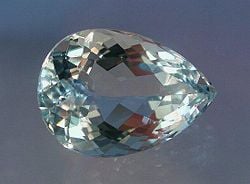Difference between revisions of "Aquamarine" - New World Encyclopedia
({{Contracted}}) |
(submitted, approved tags) |
||
| Line 1: | Line 1: | ||
| − | {{Claimed}}{{Contracted}}{{Images OK}} | + | {{Claimed}}{{Contracted}}{{Images OK}}{{Submitted}}{{Approved}} |
{{otheruses1|the mineral}} | {{otheruses1|the mineral}} | ||
{{Infobox mineral | {{Infobox mineral | ||
Revision as of 09:38, 25 February 2007
- This article is about the mineral. For other uses of the term, see Aquamarine (disambiguation).
| Aquamarine | |
|---|---|
 Aquamarine |
|
| General | |
| Category | beryl mineral variety |
| Chemical formula | Be3Al2Si6O18[1] |
| Identification | |
| Color | transparent (or can be translucent if included), greenish blue to blue green, typically light in tone[1] |
| Crystal system | hexagonal[1] |
| Cleavage | very difficult in one direction, almost never seen[1] |
| Fracture | conchoidal[1] |
| Mohs Scale hardness | 7.5 - 8[1] |
| Luster | vitreous to resinous[1] |
| Refractive index | 1.577 - 1.583 (+/- .017)[1] |
| Optical Properties | Double refractive, uniaxial negative[1] |
| Birefringence | .005 - .009[1] |
| Pleochroism | weak to moderate, blue and greenish blue; or different tones of blue with lighter tones associated with the optic axis direction [1] |
| Specific gravity | 2.72 (+.18, -.05)[1] |
Aquamarine (Lat. aqua marina, "water of the sea") is a gemstone-quality transparent variety of beryl, having a delicate blue or turquoise color, suggestive of the tint of seawater. It is closely related to the gem emerald. Colors vary and yellow beryl, called heliodor; rose pink beryl, morganite; and white beryl, goshenite are known.
Occurrence
This mineral occurs at most localities that yield ordinary beryl, some of the finest coming from Russia. The gem-gravel placer deposits of Sri Lanka contain aquamarine. Clear yellow beryl, such as occurs in Brazil, is sometimes called aquamarine chrysolite. When corundum presents the bluish tint of typical aquamarine, it is often called oriental aquamarine.
In the United States, aquamarine can be found at the summit of Mt. Antero in the Sawatch Range in central Colorado. It is the official state gem of Colorado.
In Brazil, there are mines in the states of Minas Gerais, Espírito Santo, and Bahia. Attractive aquamarine stones are also produced by Zambia, Madagascar, Malawi, Tanzania and Kenya.
The biggest aquamarine ever mined was found at the city of Marambaia, Minas Gerais, Brazil, in 1910. It weighed over 110 kg, and its dimensions were 48.5 cm long and 42 cm in diameter.
Characteristics
Aquamarine is a beryl with a hexagonal crystal structure and a chemical formula of Be3Al2Si6O18, a beryllium aluminium silicate mineral. It has a specific gravity of 2.68 to 2.74 and a Mohs hardness of from 7.5 to 8. Aquamarine typically is on the low end of the specific gravity range, normally at less than 2.7. The pink variety exhibits a high specific gravity of around 2.8. Refractive indices range around 1.57 to 1.58.
Much of today's aquamarine is heated to give it a better color blue. The deeper the blue color, the more valuable the gem is considered.
Cultural and historical/mythical usage
- Aquamarine is the birthstone associated with March. It is also the gemstone for the 19th Anniversary.
- People in the Middle Ages thought that aquamarine could magically overcome the effects of poison.
- Ancient sailors traveled with aquamarine crystals, believing that it would ensure a safe passage, and often slept with the stones under their pillow to ensure sound sleep. They believed the siren’s (mermaid) fish-like lower body was made of aquamarine.
See also
Footnotes
ReferencesISBN links support NWE through referral fees
- Farndon, John, 2006. The Practical Encyclopedia of Rocks & Minerals: How to Find, Identify, Collect and Maintain the World's best Specimens, with over 1000 Photographs and Artworks. Lorenz Books. ISBN 0754815412 (ISBN-13: 978-0754815419)
- Hurlbut, Cornelius S., and Klein, Cornelis, 1985. Manual of Mineralogy (20th ed.). New York, NY: John Wiley and Sons. ISBN 0-471-80580-7.
- Pellant, Chris, 2002. Smithsonian Handbooks: Rocks and Minerals. New York, NY: DK Adult. ISBN 0789491060 (ISBN-13: 978-0789491060)
- Shaffer, Paul R., Herbert S. Zim, and Raymond Perlman, 2001. Rocks, Gems and Minerals. Revised and Updated edition. St. Martin's Press, Golden Guide. ISBN 1582381321 (ISBN-13: 978-1582381329).
- Weinstein, Michael (1967). The World of Jewel Stones. New York, NY: Sheridan House. ASIN: B000IN1RC4.
External links
- Aquamarine "Gem by Gem" series. International Colored Gemstone Association. Retrieved February 8, 2007.
- "Flawless Aquamarine: March Birthstone" Diamond Bug. Retrieved February 8, 2007.
Credits
New World Encyclopedia writers and editors rewrote and completed the Wikipedia article in accordance with New World Encyclopedia standards. This article abides by terms of the Creative Commons CC-by-sa 3.0 License (CC-by-sa), which may be used and disseminated with proper attribution. Credit is due under the terms of this license that can reference both the New World Encyclopedia contributors and the selfless volunteer contributors of the Wikimedia Foundation. To cite this article click here for a list of acceptable citing formats.The history of earlier contributions by wikipedians is accessible to researchers here:
The history of this article since it was imported to New World Encyclopedia:
Note: Some restrictions may apply to use of individual images which are separately licensed.